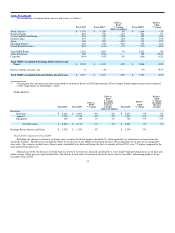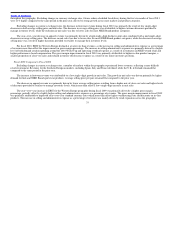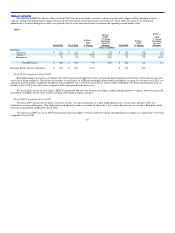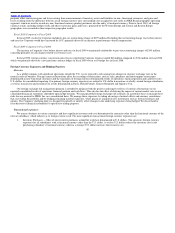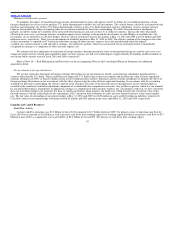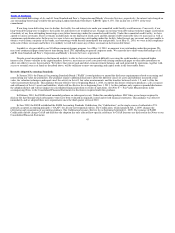Nike 2010 Annual Report Download - page 44
Download and view the complete annual report
Please find page 44 of the 2010 Nike annual report below. You can navigate through the pages in the report by either clicking on the pages listed below, or by using the keyword search tool below to find specific information within the annual report.
Table of Contents
2. Non−Functional Currency Revenues — A portion of our Western Europe geography revenues are earned in currencies other than the Euro (e.g.
British Pound), but are recognized at a subsidiary that uses the Euro as its functional currency, generating foreign currency exposure.
3. Other Revenues and Costs — Non−functional currency revenues and costs, such as endorsement contracts, intercompany royalties and other
payments, generate foreign currency risk to a lesser extent.
4. Non−functional Currency Assets and Liabilities — Our global subsidiaries have various assets and liabilities, primarily receivables and
payables, that are denominated in currencies other than their functional currency. These balance sheet items are subject to remeasurement which
may create fluctuations in other (income) expense, net within our consolidated results of operations.
Managing transactional exposures
Transactional exposures are managed on a portfolio basis within our foreign currency risk management program. As of May 31, 2010, we use
currency forward contracts and options with maturities up to 18 months to hedge the effect of exchange rate fluctuations on probable forecasted future cash
flows, including non−functional currency revenues and expenses. These are accounted for as cash flow hedges in accordance with the accounting standards
for derivatives and hedging. The fair value of these instruments at May 31, 2010 and 2009 was $206 million and $248 million in assets and $25 million and
$12 million in liabilities, respectively. The effective portion of the changes in fair value of these instruments is reported in other comprehensive income
(“OCI”), a component of shareholders’ equity, and reclassified into earnings in the same financial statement line item and in the same period or periods
during which the related hedged transactions affect earnings. The ineffective portion was a gain of $5 million for the year ended May 31, 2010. The
ineffective portion was immediately recognized in earnings as a component of other (income) expense, net. Ineffectiveness was not material for the years
ended May 31, 2010, 2009 and 2008.
Certain currency forward contracts used to manage foreign exchange exposure of non−functional currency assets and liabilities subject to
remeasurement are not designated as hedges under the accounting standards for derivatives and hedging. In these cases, the change in value of the
instruments is intended to offset the foreign currency impact of the remeasurement of the related non−functional currency asset or liability. The fair value of
these instruments at May 31, 2010 and 2009 was $104 million and $13 million in assets and $140 million and $34 million in liabilities, respectively. The
change in value of these instruments is immediately recognized in earnings. The impact of such instruments is included in other (income) expense, net and
aims to offset foreign currency remeasurement gains and losses of the exposures being hedged.
Refer to Note 18 — Risk Management and Derivatives in the accompanying Notes to the Consolidated Financial Statements for additional
quantitative detail.
Translational exposures
Substantially all of our foreign subsidiaries operate in functional currencies other than the U.S. dollar. Fluctuations in currency exchange rates create
volatility in our reported results as we are required to translate the balance sheets and operational results of these foreign currency denominated subsidiaries
into U.S. dollars for consolidated reporting. The translation of foreign subsidiaries non−U.S. dollar balance sheets into U.S. dollars for consolidated
reporting results in a cumulative translation adjustment to OCI within shareholders’ equity. In preparing our consolidated statements of income, foreign
exchange rate fluctuations impact our operating results as the revenues and expenses of our foreign operations are translated into U.S. dollars. In translation,
a weaker U.S. dollar in relation to foreign functional currencies benefits our consolidated earnings whereas a stronger U.S. dollar reduces our consolidated
earnings. The impact of foreign exchange rate fluctuations on the translation of our consolidated revenues and income before income taxes was a net
translation benefit (detriment) of approximately $147 million and $33 million, respectively, for the year ended May 31, 2010 and approximately ($199)
million and $4 million, respectively, for the year ended May 31, 2009.
41


